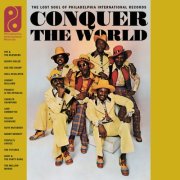 With the temperature dropping, it's time to find someone to keep you warm. Find your hookups with our online dating guide!
With the temperature dropping, it's time to find someone to keep you warm. Find your hookups with our online dating guide!
Conquer the World: The Lost Soul of Philadelphia International Records
- R&B/Soul
- 2008
- Buy the CD
Reviewed by Michael Fortes
()
But then, last year, PIR announced that it had closed in on a new deal with Sony-BMG/Legacy for worldwide distribution of its formidable catalog of classic soul recordings. It might have gone barely noticed, as many of the most popular PIR recordings had been with Sony-BMG all along anyway. It was the post-1976 recordings that were handled elsewhere – the ’76-’87 catalog had been distributed by Capitol, while the label’s scant releases from ’91-’95 were with BMG before that entity merged with Sony. And then there was that posthumous Phyllis Hyman album from ’98 that Capitol manufactured…you get the picture.
Anyway, all the confusion is over (we hope), as PIR’s recordings are under one roof. And out of this new arrangement comes this mostly excellent collection of rare singles by some mostly obscure PIR artists.
In spite of the big deal over finally uniting PIR’s entire catalog, Conquer the World: The Lost Soul of Philadelphia International Records only covers that glorious golden period of the label’s history that had been with Sony all along: 1971-75. This is by no means a bad thing – the disco, smooth jazz and synth-driven material the label embraced in later years wouldn’t have sat well with the old soul nuggets gathered here. Indeed, ’76-’98 might as well have not even happened.
This is good news for Bunny Sigler, who gets some due recognition in the process. Despite remaining largely unknown to pop audiences, he had the greatest success of the artists represented on Conquer the World, having produced and co-written some songs (not hits, but songs on successful albums nonetheless) for the O’Jays, and scoring some respectable R&B hits after leaving PIR for Salsoul. He has three entries here, including a duet with Dee Dee Sharp (“Conquer the World Together”) that’s a dead ringer for the Motown duo of Marvin Gaye and Tami Terrell. Then there’s the punchy soundtrack tune that didn’t end up appearing in the actual film, “Theme for Five Fingers of Death” (apparently Sigler was a big fan of kung fu); and “Everybody Needs Good Lovin’ (Parts 1 & 2),” which comes off like James Brown and Sly Stone putting their heads together for a Philly-style funk jam.
The obscure funk rock group Yellow Sunshine is here too – they released one album on the PIR subsidiary Gamble, before disappearing completely after a couple of members joined the PIR house band MFSB. And then there’s Ruth McFadden, no relation to Gene of McFadden and Whitehead fame. Jazzy-bluesy cuts from Pat & the Blenders (“Hard Workin’ Man”) and People’s Choice (“The Big Hurt”) are here, and prototypical Philly balladry from the Futures (“Love is Here”)… 16 cuts in all, and not a single clunker in the bunch.
That’s the good news.
The bad news? Who are these folks, anyway? For a disc containing music by artists who are largely unknown outside of hardcore soul fanatics, there’s little in the way of biographical liner notes. There is a short essay, true, but not much in the way of background information on the artists. Something else the essay could have addressed is the editing on “Makin’ Up Time (Parts 1 & 2).” Unlike the other two-part singles, “Makin’ Up Time” fades out and back in again mid-song, like an 8-track switching programs without the “cha-chunk.” Could the original master tapes be missing? Were the 45 RPM edits the only tapes that could be recovered? The listener is left guessing.
And how about those goofy red and yellow blazers worn by Yellow Sunshine on the front cover? OK, it was the ‘70s, so questionable presentation is a given. But at the end of the day, it’s hard to argue with the quality of the music.
You can follow us on Twitter and Facebook for content updates. Also, sign up for our email list for weekly updates and check us out on Google+ as well.











